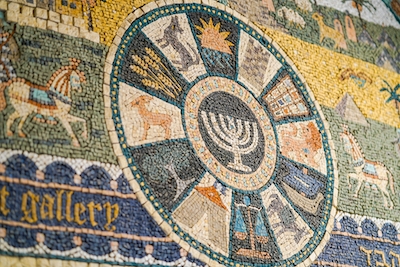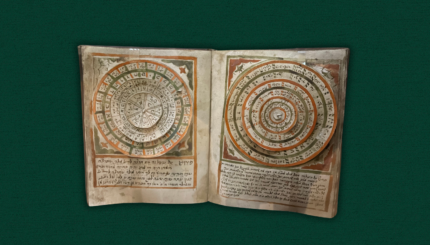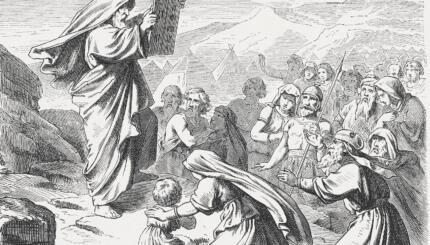Kiruv, from the Hebrew root meaning “near,” refers to outreach efforts by Orthodox Jews to draw less observant Jews closer to traditional religious practice. It was once common to hear people speak of kiruv rechokim (“drawing close those who are far”), but today it’s more typical to just say kiruv. Kiruv is not an effort to bring non-Jews into the Jewish fold; rather, it is aimed specifically at encouraging those who are already Jewish to be more observant.
As an organized effort, the history of kiruv is often traced to postwar America, though some consider legends about the patriarch Abraham preaching monotheism to be an early example, thus rooting kiruv in ancient Jewish text and practice. But it was only in the 1960s, with the establishment of several yeshivas catering directly to less knowledgeable Jews and the early growth of the network of Chabad Hasidic emissaries, that the effort became professionalized. By the late 1980s, there were sufficient numbers working in the field that a professional network, the Association for Jewish Outreach Professionals (later the Association for Jewish Outreach Programs) was formed. By some estimates, as many as 7,000 men and women work as kiruv professionals in the United States, with many thousands more in Israel and all over the world. Countless others may do kiruv work on an informal or personal basis.
Chabad is by far the largest organized kiruv effort in the world, with some 5,000 emissaries operating across the United States and in 100 other countries. Inspired by the movement’s late leader, Rabbi Menachem Mendel Schneerson, who warned in 1964 that assimilation and intermarriage constituted “spiritual crematoria” just as devastating as the actual crematoria built by the Nazis, thousands of idealistic emissaries fanned out across the globe in an effort to draw fellow Jews closer to traditional religious observance.
Two other non-Hasidic Israel-based organizations, Ohr Somayach and Aish (formerly Aish HaTorah), also operate internationally and are considered pioneers in the field. Ohr Somayach was founded in the early 1970s in Jerusalem by four rabbis, one of whom, Noach Weinberg, split off to found Aish HaTorah in 1974. Like Schneerson, Weinberg considered Jewish assimilation tantamount to a second Holocaust. Today, Aish operates some 30 satellite branches around the world in addition to its headquarters opposite the Western Wall in Jerusalem.

Help us keep Jewish knowledge accessible to millions of people around the world.
Your donation to My Jewish Learning fuels endless journeys of Jewish discovery. With your help, My Jewish Learning can continue to provide nonstop opportunities for learning, connection and growth.
The early success of these and other initiatives gave rise to what has been called the Baal Teshuvah movement, in which significant numbers of formerly secular Jews came to embrace Orthodox practice. The phenomenon was noted by President Ronald Reagan in a 1984 speech and has been the subject of numerous magazine and scholarly articles. A 1986 cover story on the subject in New York Magazine reported that one Orthodox synagogue on the Upper West Side of Manhattan had seen a fourfold jump in Shabbat attendance in less than a year.
The methods of kiruv vary. The Chabad approach largely relies on the warmth and inviting nature of their emissaries, who are well-known for providing all comers with free meals, classes and religious services. Aish and Ohr Somayach operate on a traditional yeshiva model, seeing immersive Torah study, tailored to the particular needs of those with little to no knowledge of Judaism, as the path to religious commitment. Aish’s “signature program” is its Discovery Seminar, which seeks to inspire further study by persuading participants of a rational basis for the Torah’s divine origin. Those who do kiruv work informally may simply invite the less observant for a Shabbat meal and hope they get inspired.
The impulses behind the kiruv effort are similarly varied. For some activists, it’s demographic. The results of the 1990 National Jewish Population Survey, which found that a majority (52 percent) of Jews were intermarried, sparked a round of hand-wringing over a “second Holocaust” based on the assumption — fiercely contested in some quarters — that the children of intermarried couples were less likely to be Jewishly affiliated. For others, kiruv is considered a religious responsibility akin to keeping kosher or observing the Sabbath. Various textual sources are cited for this obligation, including the talmudic dictum that “all Israel is responsible for one another” (Shevuot 39a) and the biblical obligation to rebuke your neighbor if they sin. As Maimonides writes: “It is a mitzvah for a person who sees that his fellow Jew has sinned or is following an improper path to correct his behavior and to inform him that he is causing himself a loss by his evil deeds, as it states (Leviticus 19:17): ‘You shall surely admonish your colleague.’”
Kiruv is not without its critics, with some likening Aish and similar groups to cults in which adherents are pressured to adopt particular lifestyles and are promised fulfillment and happiness if only they strictly follow the program. Others have criticized the groups for preying on vulnerable young people searching for meaning in their lives and prompting them to distance themselves from their less observant families. Aish rejects this characterization out of hand, arguing that it encourages rational thought and free thinking and is solely interested in educating Jews about their heritage.



